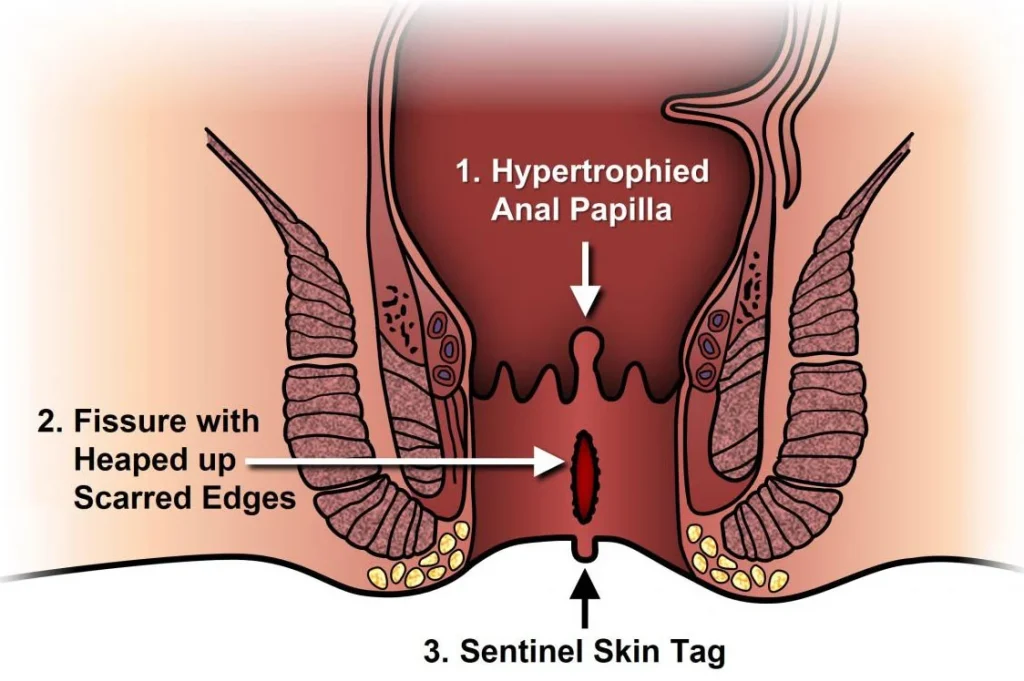Anal fissure, also known as anal crack, is among the commonly seen proctologic diseases in the community. Pain in the anus and fresh blood on the tissue after bowel movements are the predominant symptoms of anal fissure.

The diagnosis and treatment of anal fissure are straightforward, and the most crucial aspect for patients is to start the treatment process as soon as possible.
If left untreated, it may become chronic, making treatment more challenging and economically burdensome.
What is Anal Fissure?
Anal fissure refers to the condition where the thin tissue around or inside the anus is cracked or torn. These cracks usually occur inside or outside the anus.
It can occur due to reasons such as straining during bowel movements, constipation, diarrhea, passing hard stools through the anus, or childbirth. (1)
What are the Symptoms of Anal Fissure?
Pain: The most notable symptom is pain felt during and after bowel movements. The pain is usually sharp and burning in nature and can result from muscle spasms (sphincter spasms) caused by the crack.
Bleeding: Anal fissure can often cause a small amount of bright red bleeding during bowel movements. This bleeding is usually in the form of blood smeared on the surface of the stool.
Itching and Inflammation: There may be itching and mild inflammation in the area of the crack.
Sensitivity Around the Anus: There may be sensitivity and discomfort in the region where the crack is located.
Constipation and Difficulty in Bowel Movements: Due to pain, individuals may experience straining during bowel movements and constipation.
How to Get Rid of Anal Fissure?
The most crucial aspect is to consult a proctology specialist rather than hiding the disease or pretending that nothing happened. The purpose of the examination is to determine whether the disease is acute or chronic and to establish the appropriate treatment process accordingly.
In the treatment of acute fissure patients, treatment may be possible by correcting bowel movement errors, such as preventing constipation, and using anal fissure creams such as Anuflex, which aim to resolve uncontrolled contracting muscles. Drug treatment may be sufficient for new (acute) patients.
For chronic anal fissure patients, methods such as Botulinum toxin can be applied. Surgery may also be recommended but is usually not deemed necessary. (2)
How is Anal Fissure Treatment Performed?
High-Fiber Diet: Consuming foods rich in fiber can help soften the stool and facilitate easier passage. This can contribute to reducing pain in the fissure area. Whole grains, vegetables, fruits, and legumes are rich in fiber. (3)
Adequate Water Intake: Drinking at least 8 glasses of water a day can help soften the stool and promote better healing of the fissure area.
Stool Softeners and Laxatives: Upon the recommendation of your doctor, using stool softeners or laxatives can reduce straining during bowel movements.
Topical Anesthetics and Creams: Applying topical anesthetics (pain-relieving medications) or creams to the fissure area can alleviate pain and itching.
Sitz Baths: Sitz baths done by sitting in a tub of warm water can help clean and soothe the anal area.
Analgesic Medications: Over-the-counter analgesics (pain relievers) can be used as recommended by the doctor to alleviate pain.
Botulinum Toxin Injections: In some cases, the doctor may recommend Botulinum toxin injections. This can relax the anal muscles, promoting the healing of the fissure.
Surgical Intervention: In certain cases, especially for long-term and treatment-resistant fissures, surgical intervention may be considered. A procedure called lateral internal sphincterotomy (LIS) aims to relax the anal muscles by making a cut in the anus muscles.
REFERENCE
- Zaghiyan, K. N., & Fleshner, P. (2011). Anal fissure. Clinics in colon and rectal surgery, 24(01), 022-030.
- Lindsey, I., Jones, O. M., Cunningham, C., & Mortensen, N. M. (2004). Chronic anal fissure. Journal of British Surgery, 91(3), 270-279.
- Lund, J. N., & Scholefield, J. H. (1996). Aetiology and treatment of anal fissure. British journal of surgery, 83(10), 1335-1344.